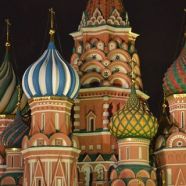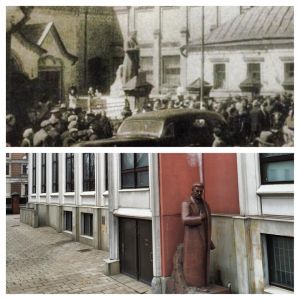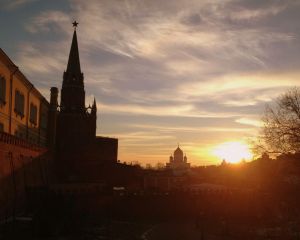The Hidden Leader
For the three and a half years that I worked in the manuscript department at the State Tretyakov Gallery in Moscow, my daily routine took me from the archive building, through the backyard, and into the administrative quarters. In my first week, I noticed a sculpture hidden in the corner of the museum’s depository. On closer inspection, I realized that the sculpture—carefully tucked away from Lavrushinsky Lane—was of the Soviet leader Joseph Stalin.
The three-and-a-half-meter-high statue, designed by sculptor Sergey Merkurov, was installed in front of the Tretyakov Gallery in 1939. Scholar Nikolai Sobolevsky gives a sense of ideological context behind the statue in his 1947 book Sculptural Statues and Monuments in Moscow, in which he describes its subject as “Stalin–Lenin’s great comrade, the leader, father and teacher to every worker, the creator of the most democratic Constitution in the world. Stalin—a genius war commander.” The sculpture, based on Merkurov’s previous depictions of Stalin that were installed at the outport of the Moscow-Volga canal and the Exhibition of Achievements of National Economy, retained the basic silhouette of its predecessors but contained a more “relatable” facial appearance.
As Stalin’s cult started to dissipate during the 1950s after his death, the sculpture was removed and was replaced in 1980 with a monument to the gallery’s founder, nineteenth-century merchant Pavel Tretyakov. It was around this time that the sculpture took up its obscured current position. The cult of personality that surrounded Stalin was addressed by Khrushchev’s government and given the name “de-Stalinization.”
The idea behind the monument and its contemporary meaning have only recently started to puzzle me in light of the emerging initiative to build monuments to Stalin across Russia that would replace those torn down during the process of de-Stalinization. The erection of statutes celebrating a controversial figure normally engenders one of two responses: a belief in the necessity of faithfully recognizing a nation’s history, or disbelief and horror triggered by the personal legacy of the statute’s subject. I am more prone to the second opinion; however, to some extent I can understand the first.
According to the International Memorial, a Russian historical and human rights society, around eleven million people were subject to rehabilitation due to the Soviet repressions that commenced on October 25, 1917. Millions more died due to famine from forced collectivization and Stalin’s political purges, what is today known as the “Great Terror.” With such harrowing statistics, the previous leader becomes less a figure of authority and more a figure of fear. These statistics prompt the consideration of whether such a man is worthy of commemoration. It is almost impossible to sympathize with the renewed efforts to commemorate the perpetrators of the horrifying events of Russia’s past.
Recently, a bust of Stalin designed by Zurab Tzeretelli was presented at the Governor’s Alley in the center of Moscow, a controversial presentation designed to portray Russia’s past rulers. Natalia Zotova of the BBC notes that the monuments of Stalin and Lenin are not too far from the bust of Nicholas II, whose family was executed by the Bolsheviks in 1918. Because of space constraints and the idea of a chronological representation of the country’s political history, it would be impossible to keep the leaders separate even though their placement is highly disturbing. The assassination of the Royal Family constituted an act of extreme violence and therefore the idea of placing monuments of Tsar Nicholas II, Lenin, and Stalin together seems questionable even if the compressed placement is an unintended consequence of the desire to educate people about the history of their country.
Nikolai Starikov, a political figure who supports the erection of new Stalin monuments, makes various arguments in favor of the process. In his discussion on the erection of Stalin’s statue in Surgut, he mentions the importance of remembering the positive sides of Stalin’s policy. On the one hand, one can consider as positive the scientific progress that the Soviet Union went through under Stalin’s rule. On the other, however, the moral side of this process is still questionable. Starikov questions whether these achievements would have been made without the victims and gives the straight negative answer. In his defense, historical research, which ideally would not permit any sympathies or prejudices, undoubtedly shows the evidence of solid progress. However, whether the achievements for the sake of ideology and technical progress were worth millions of politically repressed victims is highly doubtful.
Starikov also discusses Russia’s victory over Nazi Germany during the Second World War. But this national accomplishment is perhaps better commemorated from a personal rather than a political perspective. Such commemoration often is an intimate family affair, not necessarily connected to the ruling party. Russian losses in the Second World War are estimated to be as high as twenty-six and a half million people, an outcome that affected almost every Russian family across numerous generations. It is possible to approach the topic of remembrance through Marianne Hirsch’s concept of “postmemory,” which was developed in relation to children of Holocaust survivors or other traumatic historical events. In reference to the Second World War (the Great Patriotic War, as it is commonly called in Russia), this concept could be applied to further generations whose relatives participated in it. Growing up in Russia, as Victory Day approaches, schoolchildren are involved in preparations for the celebration of the Ninth of May, which is heavily supplemented by a series of movies, songs, and exhibitions on this topic of remembrance. Children are taught about unwitnessed historical events from their earliest years and learn to respect and remember the victims and events of the Second World War. Politics are undoubtedly important when analyzing an event of such a scale, however, it seems to be overrun by an emotional “postmemory” experience of the horrors of conflict. Regardless of the results of de-Stalinization, people will still primarily think of the victory as a joint action against Nazism rather than the actions of one particular person.
Having grown up in a family that views Stalin’s policies as extremely negative, I would emphasize that the views expressed here are personal. However, it is clear that once a monument to such a controversial public figure is erected, ethical questions will undoubtedly arise. The monument to Joseph Stalin, placed in the backyard of the Tretyakov Gallery, therefore becomes a symbolic expression of the matter: the monument is present, but remains shamefully hidden from the public.









